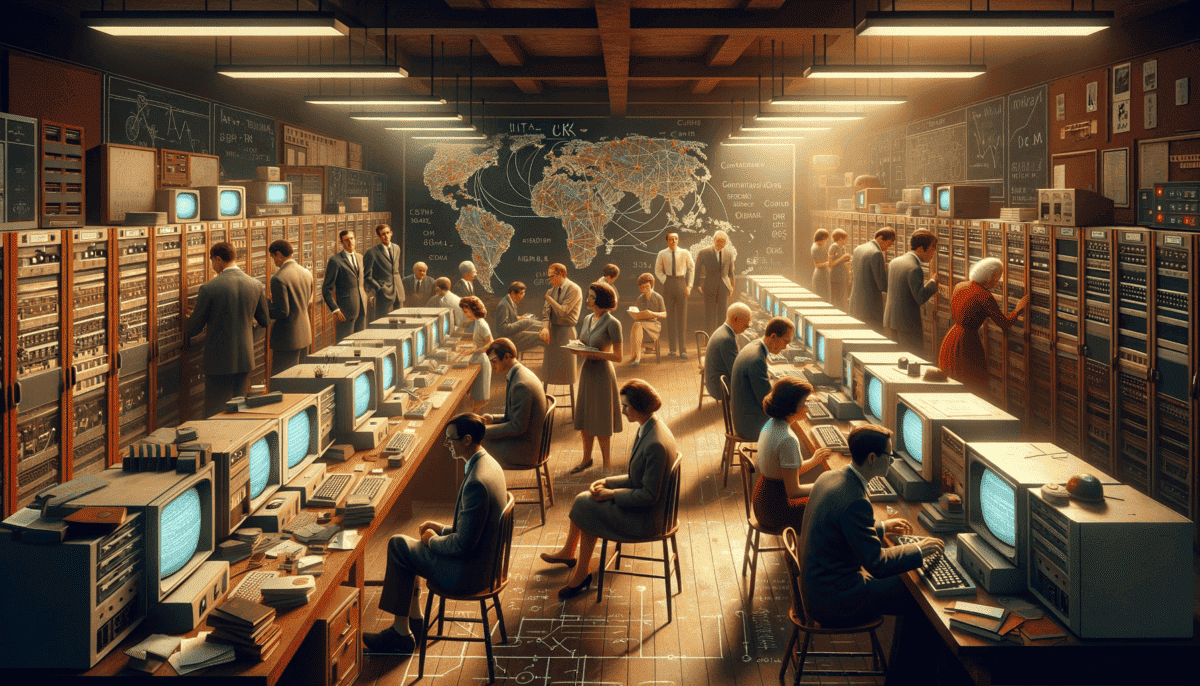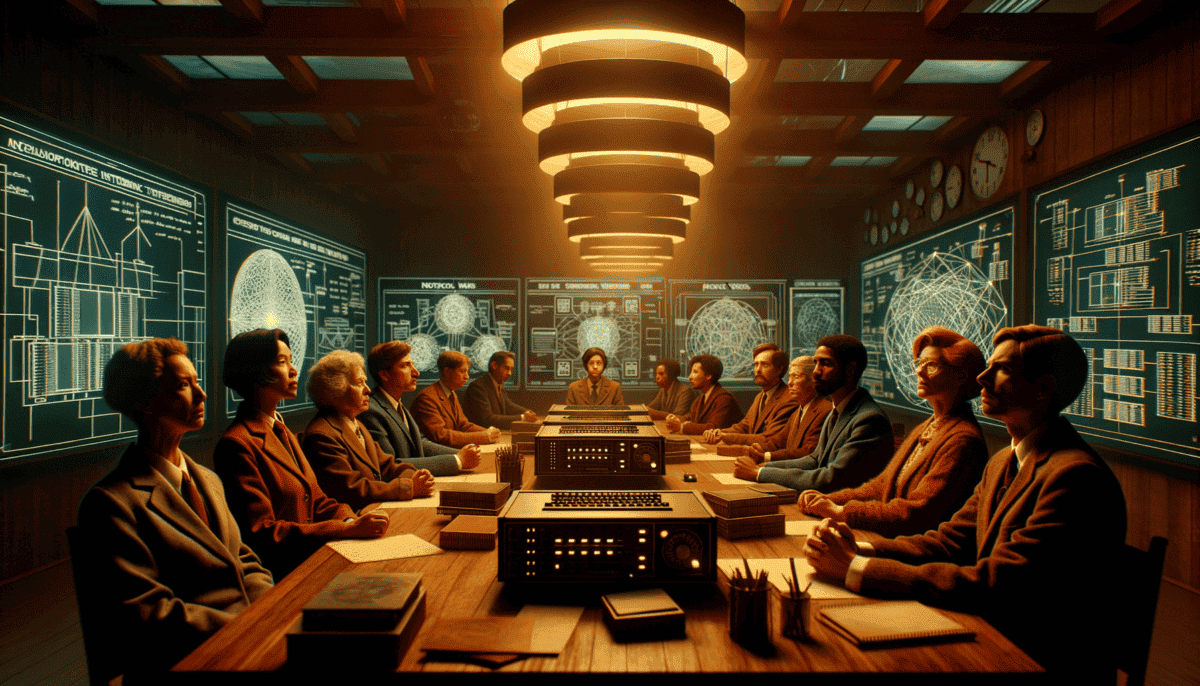The Digital Dreamers
Tommy sat at his desk, staring at his computer screen with wide eyes. His dad had just told him something amazing – computers didn't always talk to each other like they do now! ️
"Really, Dad? Computers couldn't send messages before?"
His father smiled and pulled up a chair. "Let me tell you about some very special people from the 1960s who had a big dream – to make computers talk to each other."
The Big Dream
In 1960, computers were huge machines that filled entire rooms. They worked alone, like islands. But some smart people had an idea – what if we could connect these computers?
J.C.R. Licklider was one of these dreamers. Everyone called him "Lick." He thought computers could help people work together better. He drew pictures of computers sharing information, just like friends share toys.
“Computers of the future will be everywhere,” Lick told his friends. “And they will all talk to each other!”
The Space Race Heroes
Bob Taylor worked for NASA. He had three computers in his office, but none could share with the others. It was like having three friends who couldn't play together!
Making Networks Safe
Paul Baran had another important job. He wanted to make sure computers could keep talking even if bad things happened. He thought of a clever way – break messages into tiny pieces and send them on different paths, like secret agents on a mission!
"What if one path is broken?" young Paul asked.
"No problem!" older Paul answered. "The message pieces will find another way!"
The First Steps
These brave dreamers faced big problems:
• Many people thought their ideas were silly
• The computers were very slow
• Phone lines weren't made for computer talk
• Everything was very expensive
But they didn't give up! They kept working hard because they believed in their dream.
A New World Begins
Tommy's dad pointed to their home computer. "Thanks to these dreamers, we can now send messages anywhere in the world in seconds. We can video chat with Grandma in Florida and play games with friends across the ocean!"
Tommy looked at his computer with new eyes. "Wow, Dad! Those people were like superheroes!"
His father nodded. "They sure were, Tommy. And their story was just beginning…"
Making Dreams Real
The dreamers worked in special labs with big machines. They wrote long lists of instructions to teach computers how to talk. Sometimes the computers wouldn't listen, but the dreamers kept trying.
They drew maps of their dream network on chalkboards. They had meetings that lasted all night. They drank lots of coffee and wrote many notes. Some people called them crazy, but they knew they were right.
"One day," Lick would say, "people will wonder how we ever lived without computer networks!"
And you know what? He was right!
ARPANET – The First Computer Friends
Tommy couldn’t wait to hear more about the computer dreamers. “What happened next, Dad?”
“Well, son, in 1969, something amazing happened. The dreamers built ARPANET – the first time computers became friends!”
The Big Day
On a cool October evening, scientists gathered around two computers – one in Los Angeles and one in Stanford. They were going to try something nobody had done before.
“Ready to log in?” asked the scientist in LA.
“Ready!” came the answer from Stanford.
Building Computer Roads
To make computers talk, the scientists had to build special roads for messages. But these weren’t regular roads – they were invisible paths called ‘packet-switching networks.’
Here’s how it worked:
• Break messages into tiny pieces
• Give each piece a special map
• Send pieces on different paths
• Put them back together at the end
Growing the Network
Soon, more computers wanted to join the fun! By the end of 1969, four computers could talk to each other:
– Stanford Research Institute
– UC Santa Barbara
– University of Utah
Solving Big Problems
“Did everything work perfectly, Dad?” Tommy asked.
“No, buddy. The scientists faced many challenges:”
– Sometimes messages got lost
– Computers spoke different languages
– The phone lines were very slow
– Many machines broke down
The Government Helps
The U.S. government thought ARPANET was important. They gave money to help build it. They wanted to make sure important messages could still be sent even if some computers stopped working.
“It’s like having many different paths to get to school,” Dad explained. “If one road is closed, you can take another!”
Making New Friends
Scientists started using ARPANET to share their work. They could send messages and files to friends far away. It was like a special club for smart people who loved computers!
Big Dreams Come True
Tommy’s eyes got big. “So ARPANET was like a baby internet?”
“Exactly!” Dad smiled. “Those first connections were small, but they proved the dreamers were right. Computers COULD be friends and work together!”
The scientists kept working hard. They made the network bigger and better. They solved problems and created new ways for computers to talk.
“And this was just the beginning,” Dad said with a wink. “Wait until you hear what happened when other countries wanted to join in…”
When Computers Made Friends Around the World
Tommy bounced in his seat. “Did other countries want computer friends too, Dad?”
“They sure did! While America had ARPANET, smart people in other countries were working on their own computer networks.”
British Computer Dreams
Across the ocean in England, scientists at a place called NPL (National Physical Laboratory) had big ideas. Their leader was Donald Davies, a very clever man who loved solving puzzles.
“We need our own network!” Davies told his team. “Let’s make something special!”
The NPL Network
The British team built their network differently than ARPANET. They made it super fast – like a race car compared to ARPANET’s bicycle! ️
But they had problems too:
• Not enough money
• Fewer computers to connect
• Different phone systems
• Hard to talk to American computers
Making New Rules
“But Dad, how could computers from different countries talk to each other? They speak different languages!” Tommy wondered.
“That’s right! Scientists had to make special rules – like a computer alphabet everyone could use.”
– France
– Japan
– Canada
– Germany
Different Ideas, Different Ways
Not everyone agreed on how to build these networks. Some wanted them to work like phone calls. Others wanted something completely new.
– How should messages be sent?
– Who should control the network?
– How can we make it safe?
– What rules should everyone follow?
Breaking Down Walls
Even when scientists figured out the technical problems, there were other challenges:
“Some countries didn’t want to share their computer secrets,” Dad explained. “And some people were scared of this new technology.”
Working Together
But something wonderful happened. Scientists from different countries started meeting to share ideas. They worked together to solve problems.
Getting Bigger and Better
“The dream was getting bigger,” Dad said. “Now people wanted to connect ALL the networks together!”
Tommy’s eyes went wide. “Like one big family of computers?”
“Exactly! But connecting different networks was tricky. Each one worked in its own special way.”
A Global Dream
The scientists kept working hard. They believed that one day, computers everywhere could be friends. They imagined a world where:
– Distance wouldn’t matter anymore
– Everyone could learn from each other
– The world would feel smaller and friendlier
“And you know what, Tommy? They were right! But there was still one more big dream to come – something called Project Xanadu…”
A Dream Called Xanadu
Tommy leaned forward in his chair. “What’s Xanadu, Dad? It sounds magical!” ✨
“It was magical in its own way! In 1960, a very creative thinker named Ted Nelson had a big dream about how computers could share information.”
Ted’s Big Idea
“Imagine a giant library in the sky,” Dad explained, waving his hands. “But instead of books on shelves, all the words float around and connect to each other like a spider web!”
Tommy giggled. “That sounds silly!”
“It might sound silly, but Ted’s idea was very special. He wanted to make it easy for people to:
• Find any information they wanted
• See how ideas connect
• Share their own thoughts
• Keep track of where ideas came from
• Never lose anything they wrote
The Magic of Links
“Every word could connect to other words,” Dad said. “Like magic strings tying ideas together!”
If you read about dogs, you could click to learn about:
– Different dog breeds
– How to care for pets
– Famous dogs in history
– Dog training tips
Building the Dream
“But building this magical library was REALLY hard,” Dad continued. “The computers back then weren’t strong enough.”
Ted and his team faced many challenges:
– Computers were too slow
– Not enough storage space
– Hard to make everything connect
– Too many complicated parts
Never Giving Up
“Did Ted give up?” Tommy asked.
“No! He worked on Xanadu for many, many years. He believed in his dream so much!”
Ideas That Changed the World
“Even though Xanadu didn’t work exactly like Ted wanted, his ideas were very important,” Dad explained.
“How?” Tommy asked.
“Well, when you click on links on websites today, you’re using something like Ted’s magical strings! And when you save a bookmark or share a webpage, you’re doing things Ted dreamed about.”
The Power of Dreams
“Sometimes the biggest dreams seem impossible,” Dad said softly. “But they help us think in new ways.”
Tommy thought about this. “So even if something doesn’t work perfectly, trying new things is good?”
“Exactly! Ted Nelson showed us new ways to think about information. He helped make the internet we use today more friendly and useful.”
Looking Forward
“What happened next, Dad?” Tommy asked eagerly.
“Well, while Ted was dreaming about his magical library, other scientists were working on something called ‘protocols’ – special rules to help computers talk to each other better…”
Rules of the Digital Road
“Dad, what’s a protocol?” Tommy asked, scrunching up his nose. “It sounds boring!”
“Not at all! Think of protocols like traffic rules for computers. Just like we need rules for cars to drive safely, computers need rules to talk to each other!”
The Great Protocol Race
Dad grabbed some toy cars from Tommy’s shelf. “Let me show you something fun!”
“In the 1960s, different groups made different rules for computers to talk. It was like having different languages!”
Meet TCP/IP
“The best rules came from two smart people named Vint Cerf and Bob Kahn,” Dad explained. “They made something called TCP/IP.”
“TCP/IP was like a special computer language that ALL computers could understand!”
How It Works
Dad took two paper cups and a string. “Let’s play telephone!”
– Break messages into small pieces
– Send each piece the best way possible
– Put the pieces back together
– Make sure nothing gets lost
The Big Battle
“But some people didn’t want to use TCP/IP,” Dad continued. “They liked their own rules better.”
Working Together
“What happened next?” Tommy asked.
“Something amazing! Scientists from all over the world started working together. They saw that TCP/IP was the best way for ALL computers to talk.”
“Sometimes the best ideas win because they help everyone!”
Making Friends
Dad drew a picture of computers holding hands. “TCP/IP helped computers become friends. They could share information no matter where they were!”
Testing and Learning
“Did it work right away?” Tommy wondered.
“No, they had to test it many times. Sometimes things went wrong. But each problem taught them something new.”
The Big Victory
“Finally, on January 1, 1983, something big happened,” Dad said with excitement. “All the important computer networks switched to TCP/IP on the same day!”
Growing Stronger
“As more computers joined the network, TCP/IP proved it could handle the job. It was like building a strong bridge that more and more people could cross.”
Tommy’s eyes lit up. “So these rules helped build the internet?”
“Exactly! TCP/IP was like the glue that held everything together. And it all started with people working together to solve big problems.”
Looking Ahead
“What happened after all the computers could talk to each other?” Tommy asked.
Dad smiled. “That’s when things got really exciting. The internet was about to change from a small network for scientists into something the whole world could use…”
A New World Connected
Tommy bounced excitedly in his chair. “So what happened when all the computers could finally talk to each other?”
The Big Change
“Something amazing happened,” Dad explained. “The internet grew from a tiny network for scientists into something everyone could use!”
Looking Back at the Dreams
“Remember those first dreamers we talked about?” Dad asked. “Like Dr. Licklider and his friends?”
Tommy nodded. “The ones who wanted computers to help people talk to each other!”
“Their big dreams from the 1960s helped make our internet today!”
From Small to Big
Dad pulled out his phone. “See this? It has more power than all those old computers put together!”
– A few connected computers
– To thousands
– To millions
– To billions today!
The Special Heroes
“Many people helped build the internet,” Dad said. “Scientists, engineers, and dreamers all worked together.”
Learning from the Past
“What can we learn from these internet pioneers?” Tommy asked.
“They taught us to dream big, work together, and never give up – even when things get hard!”
The Internet Today
Dad showed Tommy a map of internet connections. “Now people everywhere can learn, talk, and share ideas.”
The Future Ahead
“What’s next for the internet?” Tommy wondered.
“That’s the exciting part! New dreamers are thinking of ways to make it even better.”
“Maybe you’ll help create the next big internet idea!”
Tommy’s Dream
Tommy sat quietly for a moment. “I want to be like those internet pioneers!”
Dad smiled. “You can be! Just remember what they taught us…”
– Dream big dreams
– Work with others
– Keep trying when things are hard
– Share your ideas with the world
Tommy looked at his dad’s phone with new wonder. “It’s amazing how it all started with a few people having big dreams.”
“That’s right,” Dad said. “And those dreams from the 1960s helped create the connected world we have today. Who knows what amazing things we’ll create next?”
Tommy grinned. “I can’t wait to find out!”






